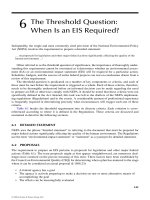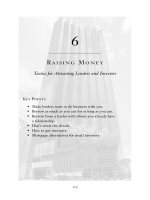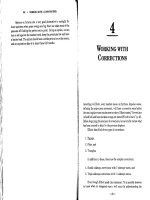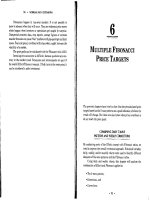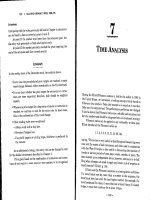Agriculture for Beginners - Chapter 6 pps
Bạn đang xem bản rút gọn của tài liệu. Xem và tải ngay bản đầy đủ của tài liệu tại đây (180.9 KB, 8 trang )
CHAPTER VI
THE DISEASES OF PLANTS
SECTION XXVII. THE CAUSE AND NATURE OF PLANT DISEASE
Plants have diseases just as animals do; not the same diseases, to be sure, but just as serious for the plant.
Some of them are so dangerous that they kill the plant; others partly or wholly destroy its usefulness or its
beauty. Some diseases are found oftenest on very young plants, others prey on the middle-aged tree, while still
others attack merely the fruit. Whenever a farmer or fruit-grower has disease on his plants, he is sure to lose
much profit.
You have all seen rotten fruit. This is diseased fruit. Fruit rot is a plant disease. It costs farmers millions of
dollars annually. A fruit-grower recently lost sixty carloads of peaches in a single year through rot which
could have been largely prevented if he had known how.
Many of the yellowish or discolored spots on leaves are the result of disease, as is also the smut of wheat,
corn, and oats, the blight of the pear, and the wilt of cotton. Many of these diseases are contagious, or, as we
often hear said of measles, "catching." This is true, among others, of the apple and peach rots. A healthy apple
can catch this disease from a sick apple. You often see evidence of this in the apple bin. So, too, many of the
diseases found in the field or garden are contagious.
Sometimes when the skin of a rotten apple has been broken you will find in the broken place a blue mold. It
was this that caused the apple to decay. This mold is a living plant; very small, certainly, but nevertheless a
plant. Let us learn a little about molds, in order that we may better understand our apple and potato rots, as
well as other plant diseases.
If you cut a lemon and let it stand for a day or two, there will probably appear a blue mold like that you have
seen on the surface of canned fruit. Bread also sometimes has this blue mold; at other times bread has a black
mold, and yet again a pink or a yellow mold.
These and all other molds are tiny living plants. Instead of seeds they produce many very small bodies that
serve the purpose of seeds and reproduce the mold. These are called spores. Fig. 112 shows how they are
borne on the parent plant.
[Illustration: FIG. 112. TANGLED THREADS OF BLUE MOLD The single stalk on the left shows how
spores are borne]
It is also of great importance to decide whether by keeping the spores away we may prevent mold. Possibly
this experiment will help us. Moisten a piece of bread, then dip a match or a pin into the blue mold on a
lemon, and draw the match across the moist bread. You will thus plant the spores in a row, though they are so
small that perhaps you may not see any of them. Place the bread in a damp place for a few days and watch it.
Does the mold grow where you planted it? Does it grow elsewhere? This experiment should prove to you that
molds are living things and can be planted. If you find spots elsewhere, you must bear in mind that these
spores are very small and light and that some of them were probably blown about when you made your
sowing. When you touch the moldy portion of a dry lemon, you see a cloud of dust rise. This dust is made of
millions of spores.
[Illustration: FIG. 113. MAGNIFIED ROSE MILDEW]
If you plant many other kinds of mold you will find that the molds come true to the kind that is planted; that
like produces like even among molds.
CHAPTER VI 61
[Illustration: FIG. 114. A MILDEWED ROSE]
You can prove, also, that the mold is caused only by other mold. To do this, put some wet bread in a
wide-mouthed bottle and plug the mouth of the bottle with cotton. Kill all the spores that may be in this bottle
by steaming it an hour in a cooking-steamer. This bread will not mold until you allow live mold from the
outside to enter. If, however, at any time you open the bottle and allow spores to enter, or if you plant spores
therein, and if there be moisture enough, mold will immediately set in.
[Illustration: FIG. 115. A HIGHLY MAGNIFIED SECTION OF DISEASED PEAR LEAF Showing how
spores are borne]
The little plants which make up these molds are called fungi. Some fungi, such as the toadstools, puffballs,
and devil's snuff-box, are quite large; others, namely the molds, are very small; and others are even smaller
than the molds. Fungi never have the green color of ordinary plants, always reproduce by spores, and feed on
living matter or matter that was once alive. Puffballs, for example, are found on rotting wood or dead twigs or
roots. Some fungi grow on living plants, and these produce plant disease by taking their nourishment from the
plant on which they grow; the latter plant is called the host.
The same blue mold that grows on bread often attacks apples that have been slightly bruised; it cannot pierce
healthy apple skin. You can plant the mold in the bruised apple just as you did on bread and watch its rapid
spread through the apple. You learn from this the need of preventing bruised or decayed apples from coming
in contact with healthy fruit.
[Illustration: FIG. 116. SPORES OF THE PEAR SCAB The spores are borne on stalks]
Just as the fungus studied above lives in the apple or bread, so other varieties live on leaves, bark, etc. Fig.
113 represents the surface of a mildewed rose leaf greatly magnified. This mildew is a fungus. You can see its
creeping stems, its upright stalk, and numerous spores ready to fall off and spread the disease with the first
breath of wind. You must remember that this figure is greatly magnified, and that the whole portion shown in
the figure is only about one tenth of an inch across. Fig. 114 shows the general appearance of a twig affected
by this disease.
Mildew on the rose or on any other plant may be killed by spraying the leaves with a solution of liver of
sulphur; to make this solution, use one ounce of the liver of sulphur to two gallons of water.
The fungus that causes the pear-leaf spots has its spores in little pits (Fig. 115). The spores of some fungi also
grow on stalks, as shown in Fig. 116. This figure represents an enlarged view of the pear scab, which causes
so much destruction.
You see, then, that fungi are living plants that grow at the expense of other plants and cause disease. Now if
you can cover the leaf with a poison that will kill the spore when it comes, you can prevent the disease. One
such poison is the Bordeaux (bôr-do') mixture, which has proved of great value to farmers.
Since the fungus in most cases lives within the leaves, the poison on the outside does no good after the fungus
is established. The treatment can be used only to prevent attack, not to cure, except in the case of a few
mildews that live on the outside of the leaf, as does the rose mildew.
=EXERCISE=
Why do things mold more readily in damp places? Do you now understand why fruit is heated before it is
canned? Try to grow several kinds of mold. Do you know any fungi which may be eaten?
CHAPTER VI 62
Transfer disease from a rotten apple to a healthy one and note the rapidity of decay. How many really healthy
leaves can you find on a strawberry plant? Do you find any spots with reddish borders and white centers? Do
you know that this is a serious disease of the strawberry? What damage does fruit mold do to peaches, plums,
or strawberries?
Write to your experiment station for bulletins on plant diseases and methods for making and using spraying
mixtures.
SECTION XXVIII. YEAST AND BACTERIA
Can you imagine a plant so small that it would take one hundred plants lying side by side to equal the
thickness of a sheet of writing-paper? There are plants that are so small. Moreover, these same plants are of
the utmost importance to man. Some of them do him great injury, while others aid him very much.
You will see their importance when you are told that certain of them in their habits of life cause great change
in the substances in which they live. For example, when living in a sugary substance they change the sugar
into a gas and an alcohol. Do you remember the bright bubbles of gas you have seen rising in sweet cider or in
wine as it soured? These bubbles are caused by one of these small plants the yeast plant. As the yeast plant
grows in the sweet fruit juice, alcohol is made and a gas is given off at the same time, and this gas makes the
bubbles.
[Illustration: FIG. 117. YEAST PLANTS A, a single plant; B, group of two budding cells; C, group of several
cells]
Later, other kinds of plants equally small will grow and change the alcohol into an acid which you will
recognize as vinegar by its sour taste and peculiar odor. Thus vinegar is made by the action of two different
kinds of little living plants in the cider. That these are living beings you can prove by heating the cider and
keeping it tightly sealed so that nothing can enter it. You will find that because the living germs have been
killed by the heat, the cider will not ferment or sour as it did before. The germs could of course be killed by
poisons, but then the cider would be unfit for use. It is this same little yeast plant that causes bread to rise.
When you see any decaying matter you may know that in it minute plants much like the yeast plant are at
work. Since decay is due to them, we take advantage of the fact that they cannot grow in strong brine or
smoke; and we prepare meat for keeping by salting it or by smoking it or by both of these methods.
You see that some of the yeast plants and bacteria, as many of these forms are called, are very friendly to us,
while others do us great harm.
Some bacteria grow within the bodies of men and other animals or in plants. When they do so they may
produce disease. Typhoid fever, diphtheria, consumption, and many other serious diseases are caused by
bacteria. Fig. 118, e, shows the bacterium that causes typhoid fever. In the picture, of course, it is very greatly
magnified. In reality these bacteria are so small that about twenty-five thousand of them side by side would
extend only one inch. These small beings produce their great effects by very rapid multiplication and by
giving off powerful poisons.
[Illustration: FIG. 118. FORMS OF BACTERIA a, grippe; b, bubonic plague; c, diphtheria; d, tuberculosis; e,
typhoid fever]
Bacteria are so small that they are readily borne on the dust particles of the air and are often taken into the
body through the breath and also through water or milk. You can therefore see how careful you should be to
prevent germs from getting into the air or into water or milk when there is disease about your home. You
should heed carefully all instructions of your physician on this point, so that you may not spread disease.
CHAPTER VI 63
SECTION XXIX. PREVENTION OF PLANT DISEASE
In the last two sections you have learned something of the nature of those fungi and bacteria that cause disease
in animals and plants. Now let us see how we can use this knowledge to lessen the diseases of our crops.
Farmers lose through plant diseases much that could be saved by proper precaution.
First, you must remember that every diseased fruit, twig, or leaf bears millions of spores. These must be
destroyed by burning. They must not be allowed to lie about and spread the disease in the spring. See that
decayed fruit in the bin or on the trees is destroyed in the same manner. Never throw decayed fruit into the
garden or orchard, as it may cause disease the following year.
Second, you can often kill spores on seeds before they are planted and thus prevent the development of the
fungus (see pp. 134-137).
Third, often the foliage of the plant can be sprayed with a poison that will prevent the germination of the
spores (see pp. 138-140).
Fourth, some varieties of plants resist disease much more stoutly than others. We may often select the
resistant form to great advantage (see Fig. 119).
Fifth, after big limbs are pruned off, decay often sets in at the wound. This decay may be prevented by coating
the cut surface with paint, tar, or some other substance that will not allow spores to enter the wound or to
germinate there.
Sixth, it frequently happens that the spore or fungus remains in the soil. This is true in the cotton wilt, and the
remedy is so to rotate crops that the diseased land is not used again for this crop until the spores or fungi have
died.
SECTION XXX. SOME SPECIAL PLANT DISEASES
=Fire-Blight of the Pear and Apple.= You have perhaps heard your father speak of the "fire-blight" of pear
and apple trees. This is one of the most injurious and most widely known of fruit diseases. Do you want to
know the cause of this disease and how to prevent it?
First, how will you recognize this disease? If the diseased bough at which you are looking has true fire-blight,
you will see a blackened twig with withered, blackened leaves. During winter the leaves do not fall from
blighted twigs as they do from healthy ones. The leaves wither because of the diseased twig, not because they
are themselves diseased. Only rarely does the blight really enter the leaf. Sometimes a sharp line separates the
blighted from the healthy part of the twig.
This disease is caused by bacteria, of which you have read in another section. The fire-blight bacteria grow in
the juicy part of the stem, between the wood and the bark. This tender, fresh layer (as explained on page 79) is
called the cambium, and is the part that breaks away and allows you to slip the bark off when you make your
bark whistle in the spring. The growth of new wood takes place in the cambium, and this part of the twig is
therefore full of nourishment. If this nourishment is stolen the plant of course soon suffers.
The bacteria causing fire-blight are readily carried from flower to flower and from twig to twig by insects;
therefore to keep these and other bacteria away from your trees you must see to it that all the trees in the
neighborhood of your orchard are kept free from mischievous enemies. If harmful bacteria exist in near-by
trees, insects will carry them to your orchard. You must therefore watch all the relatives of the pear; namely,
the apple, hawthorn, crab, quince, and mountain ash, for any of these trees may harbor the germs.
CHAPTER VI 64
[Illustration: FIG. 119. A RESISTANT VARIETY OF SEA ISLAND COTTON All the other plants in this
field died. This one row lived because it could resist the cotton wilt]
When any tree shows blight, every diseased twig on it must be cut off and burned in order to kill the germs,
and you must cut low enough on the twig to get all the bacteria. It is best to cut a foot below the blackened
portion. If by chance your knife should cut into wood containing the living germs, and then you should cut
into healthy wood with the same knife, you yourself would spread the disease. It is therefore best after each
cutting to dip your knife into a solution of carbolic acid. This will kill all bacteria clinging to the knife-blade.
The surest time to do complete trimming is after the leaves fall in the autumn, as diseased twigs are most
easily recognized at that time, but the orchard should be carefully watched in the spring also. If a large limb
shows the blight, it is perhaps best to cut the tree entirely down. There is little hope for such a tree.
A large pear-grower once said that no man with a sharp knife need fear the fire-blight. Yet our country loses
greatly by this disease each year.
[Illustration: FIG. 120. FIRE-BLIGHT BACTERIA Magnified]
It may be added that winter pruning tends to make the tree form much new wood and thus favors the disease.
Rich soil and fertilizers make it much easier in a similar way for the tree to become a prey to blight.
=EXERCISE=
Ask your teacher to show you a case of fire-blight on a pear or apple tree. Can you distinguish between
healthy and diseased wood? Cut the twig open lengthwise and see how deep into the wood and how far down
the stem the disease extends. Can you tell surely from the outside how far the twig is diseased? Can you find
any twig that does not show a distinct line of separation between diseased and healthy wood? If so, the
bacteria are still living in the cambium. Cut out a small bit of the diseased portion and insert it under the bark
of a healthy, juicy twig within a few inches of its tip and watch it from day to day. Does the tree catch the
disease? This experiment may prove to you how easily the disease spreads. If you should see any drops like
dew hanging from diseased twigs, touch a little of this moisture to a healthy flower and watch for results.
Cut and burn all diseased twigs that you can find. Estimate the damage done by fire-blight.
Farmers' bulletins on orchard enemies are published by the Department of Agriculture, Washington, D.C., and
can be had by writing for them. They will help your father much in treating fire-blight.
=Oat Smuts.= Let us go out into a near-by oat field and look for all the blackened heads of grain that we can
find. How many are there? To count accurately let us select an area one foot square. We must look carefully,
for many of these blackened heads are so low that we shall not see them at the first glance. You will be
surprised to find as many as thirty or forty heads in every hundred so blackened. These blackened heads are
due to a plant disease called smut.
[Illustration: FIG. 121. LOOSE SMUT OF OATS The glumes at a more nearly destroyed than the glumes at
b]
When threshing-time comes you will notice a great quantity of black dust coming from the grain as it passes
through the machine. The air is full of it. This black dust consists of the spores of a tiny fungous plant. The
fungous smut plant grows upon the oat plant, ripens its spores in the head, and is ready to be thoroughly
scattered among the grains of the oats as they come from the threshing-machine.
These spores cling to the grain and at the next planting are ready to attack the sprouting plantlet. A curious
thing about the smut is that it can gain a foothold only on very young oat plants; that is, on plants about an
CHAPTER VI 65
inch long or of the age shown in Fig. 121.
When grain covered with smut spores is planted, the spores develop with the sprouting seeds and are ready to
attack the young plant as it breaks through the seed-coat. You see, then, how important it is to have seed grain
free from smut. A substance has been found that will, without injuring the seeds, kill all the smut spores
clinging to the grain. This substance is called formalin. Enough seed to plant a whole acre can be treated with
formalin at a cost of only a few cents. Such treatment insures a full crop and clean seed for future planting.
Try it if you have any smut.
[Illustration: FIG. 122. A CROP FROM OATS TREATED WITH FORMALIN]
Fig. 122 illustrates what may be gained by using seeds treated to prevent smut. The annual loss to the farmers
of the United States from smut on oats amounts to several millions of dollars. All that is needed to prevent this
loss is a little care in the treatment of seed and a proper rotation of crops.
=EXERCISE=
Count the smutted heads on a patch three feet square and estimate the percentage of smut in all the wheat and
oat fields near your home. On which is it most abundant? Do you know of any fields that have been treated for
smut? If so, look for smut in these fields. Ask how they were treated. Do you know of any one who uses
bluestone for wheat smut? Can oats be treated with bluestone?
At planting time get an ounce of formalin at your drug store or from the state experiment station. Mix this
with three gallons of water. This amount will treat three bushels of seeds. Spread the seeds thinly on the barn
floor and sprinkle them with the mixture, being careful that all the seeds are thoroughly moistened. Cover
closely with blankets for a few hours and plant very soon after treatment. Try this and estimate the per cent of
smut at next harvest-time. Write to your experiment station for a bulletin on smut treatment.
[Illustration: FIG. 123. A SCABBY SEED POTATO]
[Illustration: FIG. 124. A HEALTHY SEED POTATO]
=Potato Scab.= The scab of the white, or Irish, potato is one of the commonest and at the same time most
easily prevented of plant diseases. Yet this disease diminishes the profits of the potato-grower very materially.
Fig. 123 shows a very scabby potato, while Fig. 124 represents a healthy one. This scab is caused by a
fungous growth on the surface of the potato. Of course it lessens the selling-price of the potatoes. If seed
potatoes be treated to a bath of formalin just before they are planted, the formalin will kill the fungi on the
potatoes and greatly diminish the amount of scab at the next harvest. Therefore before they are planted, seed
potatoes should be soaked in a weak solution of formalin for about two hours. One-half pint of formalin to
fifteen gallons of water makes a proper solution.
[Illustration: FIG. 125 From a scabby potato, like the one in Fig. 123, this yield was obtained]
[Illustration: FIG. 126 From a healthy potato, like the one in Fig. 124, this yield was obtained]
[Illustration: FIG. 127. EFFECT OF SPRAYING Sprayed potatoes on left; unsprayed on right]
One pint of formalin, or enough for thirty gallons of water, will cost but thirty-five cents. Since this solution
can be used repeatedly, it will do for many bushels of seed potatoes.
=Late Potato Blight.= The blight is another serious disease of the potato. This is quite a different disease from
the scab and so requires different treatment. The blight is caused by another fungus, which attacks the foliage
CHAPTER VI 66
of the potato plant. When the blight seriously attacks a crop, it generally destroys the crop completely. In the
year 1845 a potato famine extending over all the United States and Europe was caused by this disease.
[Illustration: FIG. 128. YIELD FROM TWO FIELDS OF THE SAME SIZE The one at the top was sprayed;
the one at the bottom was unsprayed]
Spraying is the remedy for potato blight. Fig. 128 shows the effect of spraying upon the yield. In this case the
sprayed field yielded three hundred and twenty-four bushels an acre, while the unsprayed yielded only one
hundred bushels to an acre. Fig. 127 shows the result of three applications of the spraying mixture on the
diseased field. Figs. 129 and 130 show how the spraying is done.
[Illustration: FIG. 129. SPRAYING MACHINE]
[Illustration: FIG. 130. SPRAYING MACHINE]
=EXERCISE=
Watch the potatoes at the next harvest and estimate the number that is damaged by scab. You will remember
that formalin is the substance used to prevent grain smuts. Write to your state experiment station for a bulletin
telling how to use formalin, as well as for information regarding other potato diseases. Give the treatment a
fair trial in a portion of your field this year and watch carefully for results. Make an estimate of the cost of
treatment and of the profits. How does the scab injure the value of the potato? The late blight can often be
recognized by its odor. Did you ever smell it as you passed an affected field?
[Illustration: FIG. 131. CLUB ROOT]
=Club Root.= Club root is a disease of the cabbage, turnip, cauliflower, etc. Its general effect is shown in the
illustration (Fig. 131). Sometimes this disease does great damage. It can be prevented by using from eighty to
ninety bushels of lime to an acre.
=Black Knot.= Black knot is a serious disease of the plum and of the cherry tree. It attacks the branches of the
tree; it is well illustrated in Fig. 132. Since it is a contagious disease, great care should be exercised to destroy
all diseased branches of either wild or cultivated plums or cherries. In many states its destruction is enforced
by law. All black knot should be cut out and burned some time before February of each year. This will cost
little and save much.
[Illustration: FIG. 132. BLACK KNOT]
=Peach Leaf Curl.= Peach leaf curl does damage amounting to about $3,000,000 yearly in the United States. It
can be almost entirely prevented by spraying the tree with Bordeaux mixture or lime-sulphur wash before the
buds open in the spring. It is not safe to use strong Bordeaux mixture on peach trees when they are in leaf.
[Illustration: FIG. 133. MOLDY PEACHES]
=Cotton Wilt.= Cotton wilt when it once establishes itself in the soil completely destroys the crop. The fungus
remains in the soil, and no amount of spraying will kill it. The only known remedy is to cultivate a resistant
variety of cotton or to rotate the crop.
[Illustration: FIG. 134. PEACH MUMMIES]
=Fruit Mold.= Fruit mold, or brown rot, often attacks the unripe fruit on the tree, and turns it soft and brown
and finally fuzzy with a coat of mildew. Fig. 133 shows some peaches thus attacked. Often the fruits do not
CHAPTER VI 67
fall from the trees but shrivel up and become "mummies" (Fig. 134). This rot is one of the most serious
diseases of plums and peaches. It probably diminishes the value of the peach harvest from 50 to 75 per cent.
Spraying according to the directions in the Appendix will kill the disease.
[Illustration: FIG. 135. HALF OF TREE SPRAYED TO PREVENT PEACH CURL Note the difference in
foliage and fruit on the sprayed and unsprayed halves of the tree, and the difference in yield shown below]
CHAPTER VI 68




